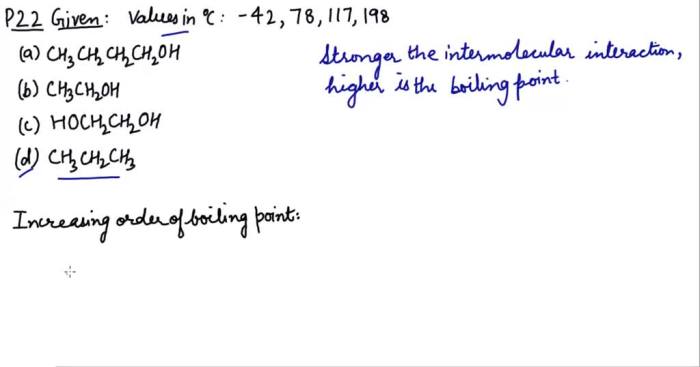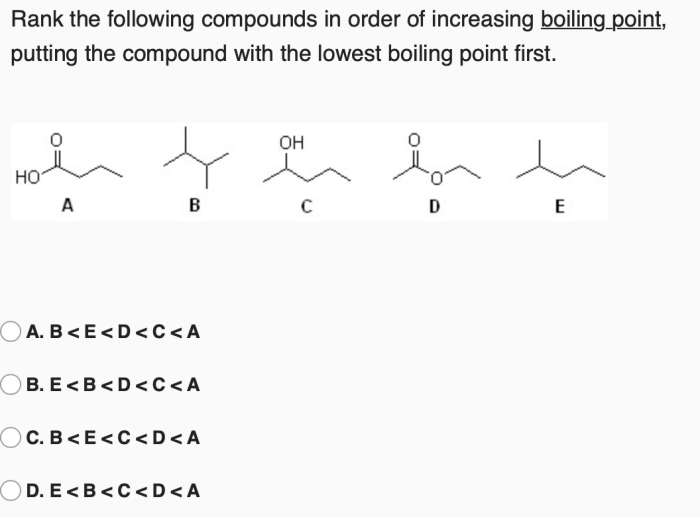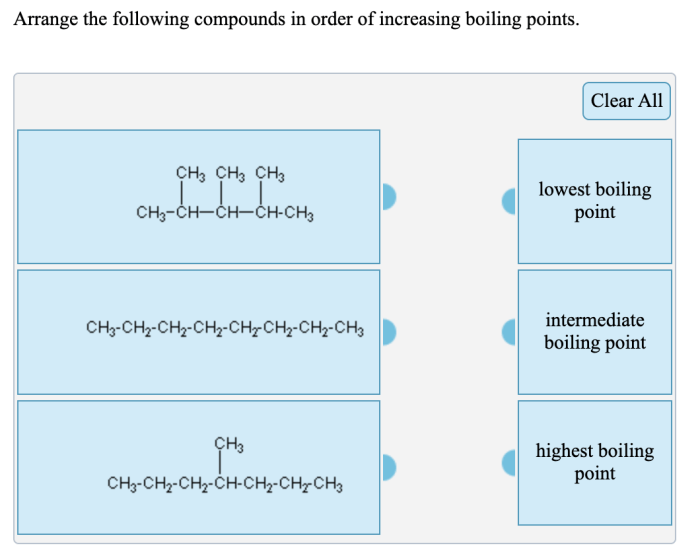Arrange the molecule in the order of increasing boiling point – Delving into the fascinating realm of intermolecular forces and molecular structure, this discourse explores the intricate relationship between these factors and the boiling points of molecules. By examining the diverse intermolecular interactions, molecular size and shape, branching and functional groups, as well as resonance and conjugation, we unravel the fundamental principles that govern the boiling point behavior of molecules.
Boiling point, a crucial physical property, serves as a valuable indicator of a molecule’s intermolecular interactions and molecular complexity. As we embark on this scientific journey, we will discover how these factors collectively influence the ease with which molecules transition from a liquid to a gaseous state.
Intermolecular Forces: Arrange The Molecule In The Order Of Increasing Boiling Point

Intermolecular forces (IMFs) play a crucial role in determining the boiling point of a substance. IMFs are the attractive forces between molecules and influence the amount of energy required to overcome the intermolecular attractions and cause the liquid to vaporize.
Types of Intermolecular Forces
- Dipole-dipole forces: These forces occur between polar molecules that have a permanent dipole moment due to uneven distribution of electrons. The positive end of one molecule attracts the negative end of another molecule, resulting in an attractive force.
- Hydrogen bonding: This is a particularly strong type of dipole-dipole force that occurs when a hydrogen atom is bonded to a highly electronegative atom (such as N, O, or F). The hydrogen atom acquires a partial positive charge, and the electronegative atom acquires a partial negative charge, leading to strong intermolecular attraction.
- van der Waals forces: These forces are weak attractive forces that occur between all molecules, regardless of their polarity. They include London dispersion forces (induced dipole-induced dipole forces) and permanent dipole-induced dipole forces.
The strength of IMFs increases in the order: van der Waals forces< dipole-dipole forces < hydrogen bonding.
Examples of Molecules with Different IMFs and Boiling Points, Arrange the molecule in the order of increasing boiling point
| Molecule | IMFs | Boiling Point (°C) | |
|---|---|---|---|
| Helium (He) | van der Waals forces | -268.9 | |
| Water (H2O) | Hydrogen bonding | 100 | |
| Methane (CH4) | van der Waals forces | -161.6 | |
| Ethanol (C2H5OH) | Dipole-dipole forces and hydrogen bonding | 78.3 |
| Molecule | Molar Mass (g/mol) | Shape | Boiling Point (°C) |
|---|---|---|---|
| Methane (CH4) | 16.04 | Tetrahedral | -161.6 |
| Ethane (C2H6) | 30.07 | Linear | -88.6 |
| Propane (C3H8) | 44.10 | Linear | -42.1 |
| Butane (C4H10) | 58.12 | Linear | -0.5 |



